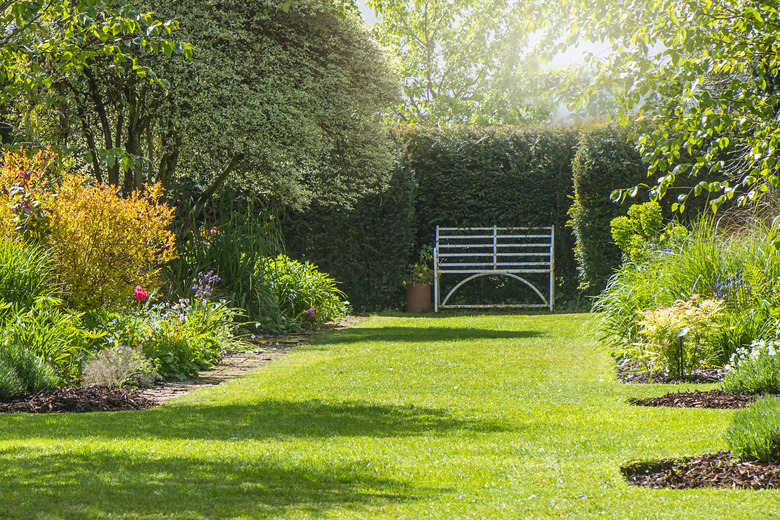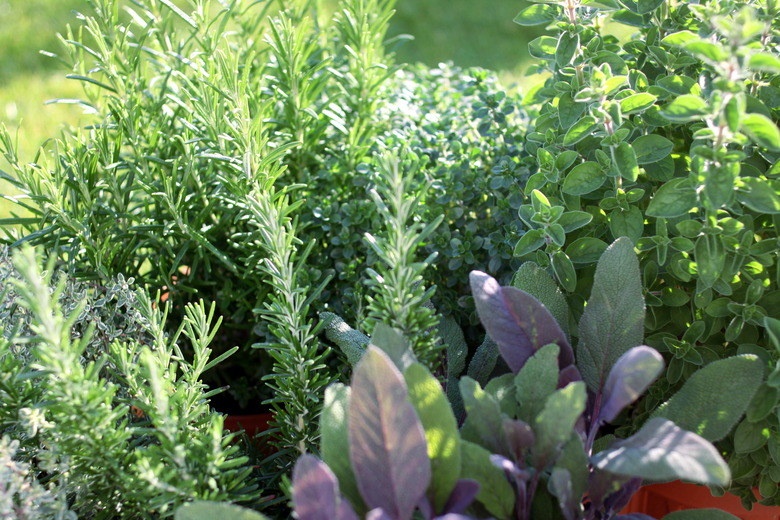Types Of Organic Pest Control In The Garden
Organic pest control refers to any number of bug-battling or critter-deterring methods that don't pollute the environment or cause harm to innocent bystanders. These can be foliar sprays, top dressings scattered on the soil, physical barriers and more. Chemically speaking, an insecticide is considered organic if it's composed of carbon-based molecules, which break down much faster than noncarbon-based (inorganic) molecules.
One of the best organic pest control methods involves simply taking good care of your plants since healthy plants produce their own natural defenses. Until then, familiarize yourself with the full breadth of environmentally friendly organic pest control methods.
Organic Pest Control Sprays
Organic Pest Control Sprays
Not all pesticide sprays are automatic no gos in an organic garden. In fact, numerous sprays and commercial products are also considered organic approved. However, these products should still be applied with caution because some can be toxic to pollinators and predatory insects. All sprays should be applied in the evening (when pollinators are not active) and only on nonflowering plants to reduce the impact on pollinators.
Examples of organic-approved insecticidal sprays include neem oil, cedar oil, cinnamaldehyde, citrus oil, garlic oil, clove oil and cottonseed oil. Pyrethrins (extracted from the Chrysanthemum genus) and spinosad (extracted from bacteria) are technically organic approved but carry a high risk of toxicity to bees. Another organic-approved spray is lime sulfur, which is highly corrosive in its undiluted form. Consider other options before resorting to these products.
Insecticidal Soap and Horticultural Oil Spray
Insecticidal Soap and Horticultural Oil Spray
Do you have water, cooking oil, dish soap and a clean spray bottle? You already have everything you need to send soft-bodied pests packing. The soap dries out some insects, like leafminers, mealybugs, mites, thrips and aphids, but it's not effective against hard-bodied insects, like beetles.
The best soap for the job has a high fatty acid content, like pure Castile soap. Stay away from soaps with extra additives, like fragrances. All you need is about 1 tablespoon of soap and 1 tablespoon of oil (e.g., vegetable oil) for every quart of warm water. You can also buy commercial insecticidal soap if you prefer.
Spray this concoction generously on the entire surface of the plant, including the stem and underside of the leaves. To avoid leaf scorch, don't apply it in the heat of the day. Insects must be directly hit with this mixture to suffer the ill effects, so it's best to reapply it every day.
Kaolin or China Clay
Kaolin or China Clay
Kaolin clay, or China clay, camouflages whatever it touches. Although not every insect is fooled, many seem to think it's just landed on a patch of dirt, not on a delicious plant. Instead of wreaking their usual havoc, these pests continue their search for food elsewhere. Meanwhile, the camouflaged plant experiences no ill effects from its mud mask.
Japanese beetles, cucumber beetles, Colorado potato beetles, thrips and squash bugs are deterred by kaolin clay. Fruit-eating birds can also be tricked into passing up clay-covered harvests.
Kaolin clay is purchased as a powder that is mixed with water in a tank sprayer. It can be applied to fruits and leaves with no ill effects. When the fruits or veggies are ready to be picked, the clay washes right off with plain water. Reapply whenever rainfall washes away the clay.
Diatomaceous Earth, or Diatomite
Diatomaceous Earth, or Diatomite
Diatomaceous earth is effective against anything that crawls. Although it looks like a fine, soft powder, it's actually very abrasive and capable of cutting through insects' exoskeletons. These little nicks and cuts expose a layer of oil and fat just under the exoskeleton, which the diatomaceous earth then absorbs. The insects die of dehydration within a few hours.
Sprinkle diatomaceous earth around any plants affected by ants or other crawling pests. Note that beneficial insects that crawl through it will also die, so consider using it only when a problem has been detected and not throughout the entire garden. Because diatomaceous earth is most effective when dry, it's ideal to use it in conjunction with underground irrigation so that you don't have to continuously reapply it.
Due to the abrasive nature of diatomaceous earth, it's not something you want to inhale or get in your eyes. It also contains silica, which can cause lung problems, including lung cancer with long-term exposure. Wear eye protection, a dust mask and gloves when handling diatomaceous earth.
Cloches and Row Covers
Cloches and Row Covers
Cloches and row covers protect plants from larger pests, especially cabbage moths and clearwing moths. Because these moths cannot land on the plant to lay their eggs, the plant won't be eaten by cabbage worms or squash vine borers. Row covers work in the same way but cover a much larger group of plants instead of individual plants. Both styles must be securely pinned to the ground to stay impenetrable to flying insects.
Cloches and row covers are typically only used early in the season to protect young plants. They must be periodically removed to allow proper air circulation around the plant's foliage to prevent mold and mildew. It's also imperative to remove row covers and cloches when the plant blooms so that pollinators can access the flowers.
Cutworm Caterpillar Collars
Cutworm Caterpillar Collars
Cutworms are caterpillars that cut down young plants by chewing right through the stems. They're particularly rampant in vegetable gardens. Fortunately, they're easily duped by a physical barrier around the stem, such as a toilet paper roll. You can also cut the tops and bottoms off tin cans or water bottles to make a cutworm collar.
Slip the homemade cutworm collar over the stem of a transplanted veggie and press it into the soil at least 1 inch deep. Make sure about 2 to 4 inches of the material remain above ground. Alternatively, place the cutworm collars in the soil before sowing seeds directly inside each protective circle. Cardboard collars should break down naturally but be sure to cut off plastic or tin collars once the plant matures to prevent inhibiting its growth.
Fences and Scare Tactics
Fences and Scare Tactics
If your garden pests happen to be mammals, you can prevent damage through the use of fences, nets and scare tactics. Underground fences work well against tunneling critters as long as they are made from a chewproof material. You can also pour a concrete barrier around the perimeter of the garden to prevent animals from digging their way in.
For above-ground fences to work, they need to be sufficiently high to prevent animals from jumping over them. In the case of deer, this could be as high as 8 feet. Ideally, the fences will also feature a slippery roll top (called a coyote roller) to prevent climbing. You might also consider an electric fence to keep out large animals. If birds steal your harvest, place bird netting over the garden or tree just before the fruit begins to ripen.
Scare tactics are an affordable alternative to fences. Sophisticated options include motion-triggered sirens, lights and sprinklers. Simple deterrents include balloons, whirlygigs and anything else that makes odd movements or sounds. Given enough time, animals may realize these objects do not pose a threat, so switch things up periodically.
Companion Planting With Aromatic Herbs
Companion Planting With Aromatic Herbs
Some pungent herbs smell delicious to us but are downright repulsive to pests. Take advantage of this by planting strong-scented herbs in your garden, such as basil (Ocimum basilicum), mint (Mentha spp.), sage (Salvia officianlis), cilantro (Coriandrum sativum) and rosemary (Salvia rosmarinus). Research incompatible combinations before you get too gung ho since some herbs can negatively affect the growth or taste of other plants. For example, garlic (Allium sativum) can repel aphids, red spider mites, cabbage worms, slugs, snails and even rabbits from celery (Apium graveolens), lettuce (Lactuca sativa), tomatoes (Solanum lycopersicum) and cabbages (Brassica oleracea var. capitata) but will stunt the growth of nearby beans (Phaseolus vulgaris).
Beneficial Animals, Insects and Bacteria
Beneficial Animals, Insects and Bacteria
Many people grow plants in an isolated environment that is well removed from their natural position in the ecosystem and food chain. Plants are supposed to be eaten by insects to a certain degree, as these insects then feed toads, skinks, birds, snakes, mice, etc. Consider whether your garden offers a suitable habitat for these beneficial animals. They'll need a water source and a place to hide in order to stick around and control the insect population.
It takes more than just a pest infestation to convince beneficial insects to move in. You're already promoting their presence by avoiding contact-based insecticides, but you can go a step further by planting certain flowers and herbs. Some predatory insects prefer to lay their eggs on certain plants, for example, whereas others supplement their diets with nectar. Yarrow (Achillea millefolium), dill (Anethum graveolens), fennel (Foeniculum vulgare) and four-wing saltbush (Atriplex canescens) will attract a nice variety of beetles, lacewings, parasitic wasps and true bugs to the garden.
Finally, some microbes also play a role in controlling insect populations. A bacterium called Bacillus thuringiensis, or Bt, can be scattered onto the garden soil or sprayed directly onto the plant, where it will fatally infect the insects that digest it. It should be used with caution around flowering plants to protect pollinators. Other microbes used as natural insecticides include the fungus Metarhizium anisopliae and the bacterium Chromobacterium subtsugae.
Removing Pests by Hand
Removing Pests by Hand
Although not an ideal method for squeamish gardeners or those with large plots, hand removal represents a completely natural pest control solution. Some insects, like Japanese beetles, are easy to spot and slow to react, making it easy to pull them off your plants. Drop them in a bucket of soapy water as you go. The water drowns them, and the soap suds prevent them from escaping the bucket.
Other insects blend into the environment, forcing you to inspect every leaf. For example, cabbage worms tend to be the same color as the leaves they eat, and they also blend into the stems or hide out under the leaves. Once you spot them, you can pull them off and put them in the soapy bucket too. If you're having a lot of trouble finding pesky insects, try visiting the garden early in the morning before they hide from the heat of the sun.
Squash borers should also be scooped out of vines by hand. Once you see the telltale "sawdust" at the base of a squash (Cucurbita spp.) vine, slit it open with a clean knife, extract the borer and pack moist dirt over the incision to prevent the plant from drying out. If you're battling aphids, you can physically remove them with a blast of water from the hose. Use as much force as possible without damaging the plant.
References
- University of Maryland Extension: Predators
- Michigan State University: How to Control Invasive Pests While Protecting Pollinators and Other Beneficial Insects
- National Cancer Institute: Crystalline Silica
- National Pesticide Information Center: Diamatoceous Earth
- Xerces Society: Comparative Overview – Organic Pesticides
- Bob Vila: All You Need to Know About Insecticidal Soap



